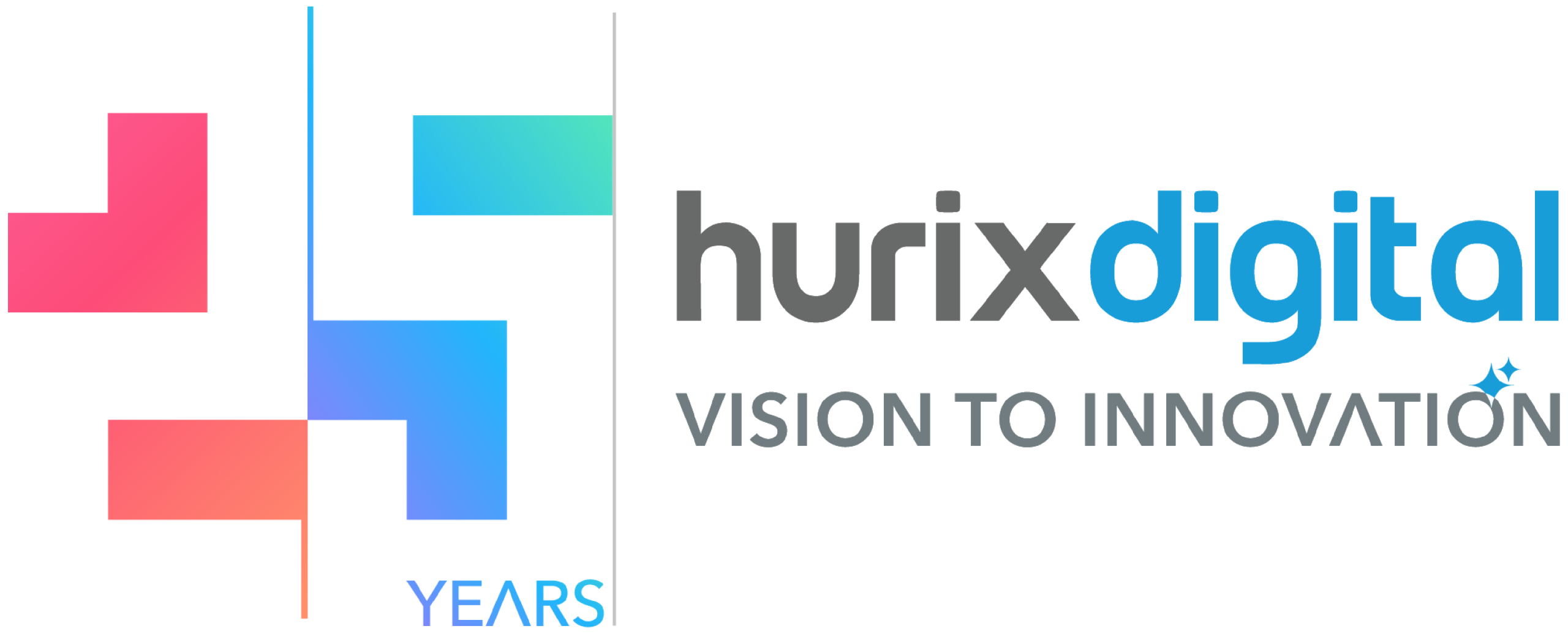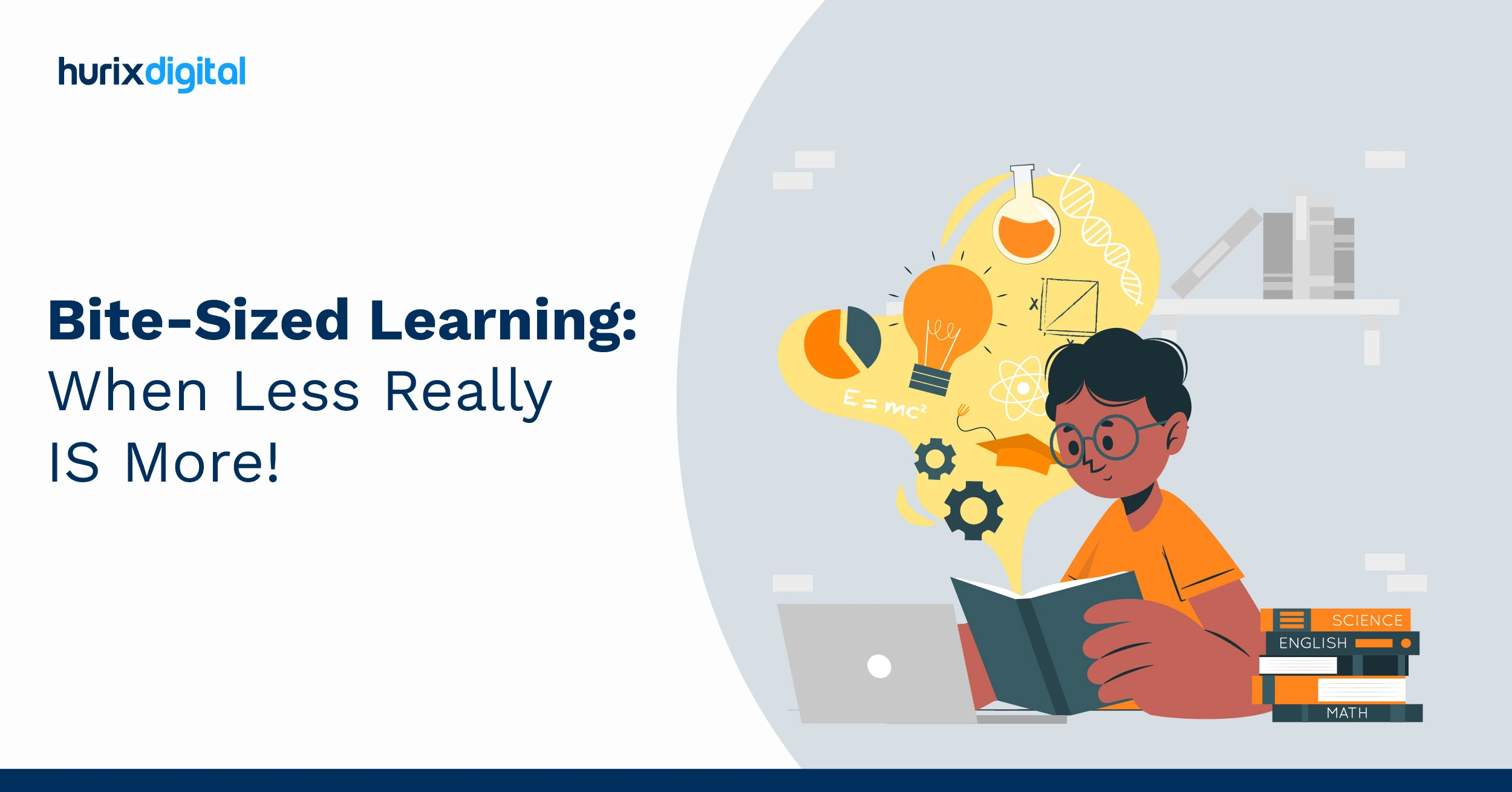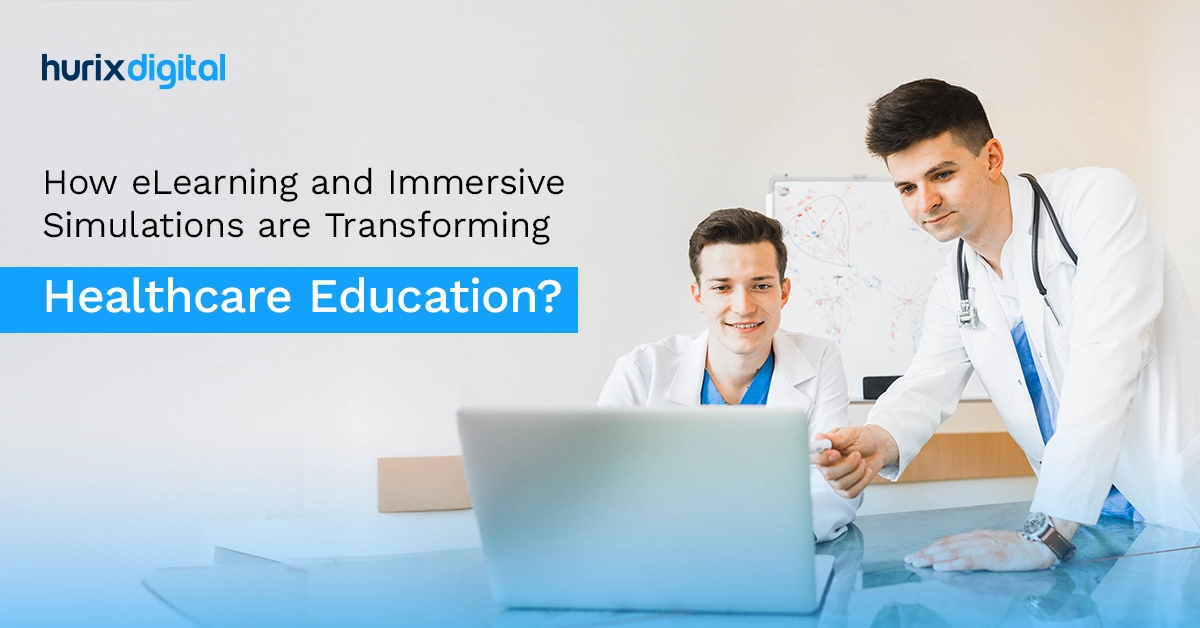
How eLearning and Immersive Simulations are Transforming Healthcare Education?
Summarize with:
eLearning in healthcare is a time-efficient, cost-effective and flexible way to provide training to healthcare practitioners and make learning more accessible. Besides, it also provides added benefits in terms of managing compliance and continuous professional development.
Patients are best helped when healthcare practitioners are up to date with the latest in healthcare information and technology and have easy access to all the information they require on the causes, symptoms and prognoses of the diseases they are treating.
eLearning in healthcare, therefore, provides a time-efficient way for healthcare professionals to stay abreast with the latest developments in the diagnosis and treatment of various illnesses and diseases. Here are some benefits of eLearning in the healthcare industry.
Table of Contents:
- The Need for Effective and Engaging Training Methods
- Immersive Simulation: A Game-Changer in Healthcare Education
- Benefits of Immersive Simulation for Healthcare Professionals
- Impact of eLearning on Healthcare Education
- The End Note
The Need for Effective and Engaging Training Methods
The healthcare industry faces a growing demand for skilled professionals who can deliver high-quality care in increasingly complex environments. According to a 2022 report by the Association of American Medical Colleges (AAMC), the United States alone will face a shortage of up to 139,000 physicians by 2033.
This necessitates effective and engaging training methods that can equip healthcare professionals with the necessary skills and knowledge to meet these evolving challenges. Medical knowledge is expanding rapidly, and healthcare professionals need to stay abreast of the latest advancements and best practices.
Limitations of Traditional Training Approaches
While traditional training methods like lectures, textbooks, and standardized tests play a crucial role in healthcare education, they often fall short of providing the practical experience needed to thrive in real-world clinical settings.
These limitations can lead to knowledge gaps and a lack of confidence in applying learned concepts to practical scenarios. Here are some challenges associated with traditional healthcare training:
- Limited access to real-world scenarios: Recreating complex medical situations in a classroom setting can be difficult and impractical.
- Risk of errors during hands-on training: Trainees practicing procedures on real patients can lead to potential harm.
- Difficulty replicating the pressure and decision-making of real-world situations.
- Challenges in tailoring training to individual learning styles.
Immersive Simulation: A Game-Changer in Healthcare Education
The immersive simulation utilizes cutting-edge technologies like VR and AR to create realistic and interactive training environments. These environments allow healthcare professionals to practice procedures, manage complex medical situations, and make critical decisions in a safe, controlled setting.
Research shows evidence that VR simulation training improved surgical skills and instilled confidence in trainees compared to traditional methods.
VR and AR Technologies in Healthcare Training
- Virtual Reality (VR): VR technology creates a completely immersive virtual environment where healthcare professionals can interact with simulated patients, medical equipment, and clinical scenarios.
- Augmented Reality (AR): AR technology overlays digital information onto the real world. In healthcare training, AR allows users to visualize anatomical structures, practice procedures on virtual models superimposed on physical mannequins, or receive real-time feedback during simulations.
Benefits of Immersive Simulation for Healthcare Professionals
The effectiveness of healthcare simulation technology training is clearly outlined in the benefits listed below:
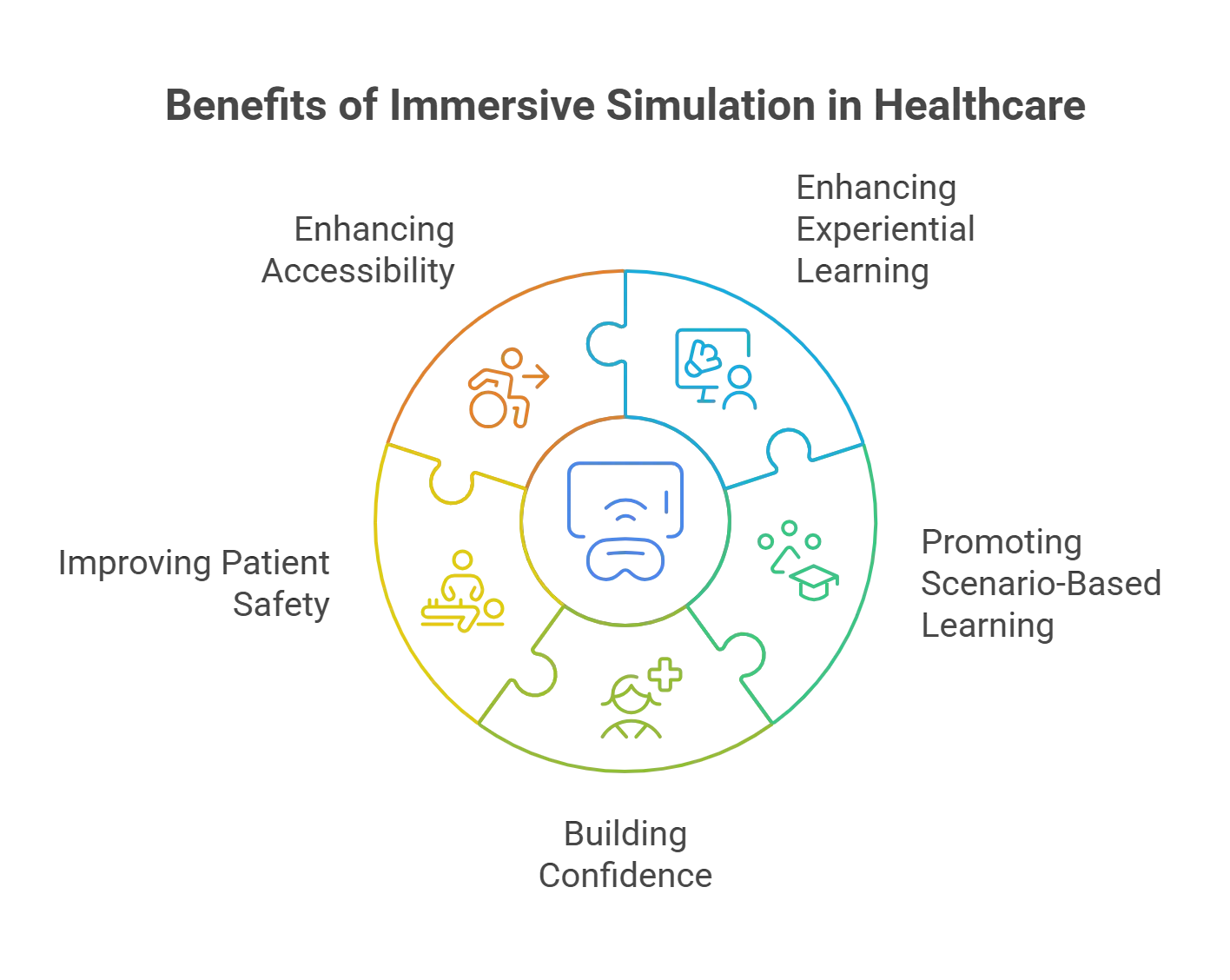
1. Enhancing Experiential Learning and Skill Development:
Immersive simulation offers a unique opportunity for experiential learning, enabling healthcare professionals to practice skills in a safe and controlled environment. This hands-on approach fosters deeper understanding, improves muscle memory, and facilitates the development of critical technical skills.
VR and AR simulations place healthcare professionals in realistic clinical environments, allowing them to practice procedures, manage complex situations, and make critical decisions – all within a safe, controlled setting.
2. Promoting Scenario-Based Learning and Decision-Making
Healthcare professionals can be exposed to a wide range of realistic scenarios through immersive simulations. These scenarios can be tailored to specific specialties and learning objectives, enabling participants to practice decision-making skills, communication strategies, and crisis management in a simulated environment.
Immersive simulation scenarios can be designed to focus on communication and collaboration within a healthcare team. By practicing teamwork in a simulated surgical setting, healthcare professionals can develop effective communication strategies and refine their ability to work cohesively as a unit.
3. Building Confidence and Reducing Stress in High-Pressure Situations
Immersive simulation allows healthcare professionals to practice procedures and manage complex situations in a risk-free environment, helping build confidence and reduce stress. This translates into improved performance and better patient outcomes when faced with similar situations in real-world clinical settings.
The realistic and interactive nature of immersive simulations helps healthcare professionals build confidence in their abilities. They can develop the composure and critical thinking skills necessary for success in real-world situations.
4. Improving Patient Safety through Risk-Free Training
Traditional training methods often involve practicing procedures on mannequins or standardized patients. Immersive simulation offers a safer alternative, allowing healthcare professionals to make mistakes and learn from them without jeopardizing patient safety.
Immersive simulations provide a safe space for healthcare professionals to practice high-risk procedures and hone their skills without the risk of harming real patients. This helps trainees gain valuable experience in identifying and managing medical emergencies, performing complex surgeries, and administering delicate treatments.
5. Enhancing Accessibility and Scalability of Healthcare Training
Immersive simulation offers a scalable and accessible approach to healthcare training. VR and AR simulations can be easily deployed across various locations, allowing healthcare professionals to access training opportunities regardless of geographical constraints.
VR and AR training modules can be easily distributed and accessed by healthcare professionals at their convenience, regardless of location. Additionally, immersive simulation programs can be readily scaled to accommodate larger training groups, making them a cost-effective solution in the long run.
Impact of eLearning on Healthcare Education
From increasing accessibility to flexibility, eLearning has improved many aspects of healthcare and medical education. Let’s explore eLearning’s impact on improving healthcare education:
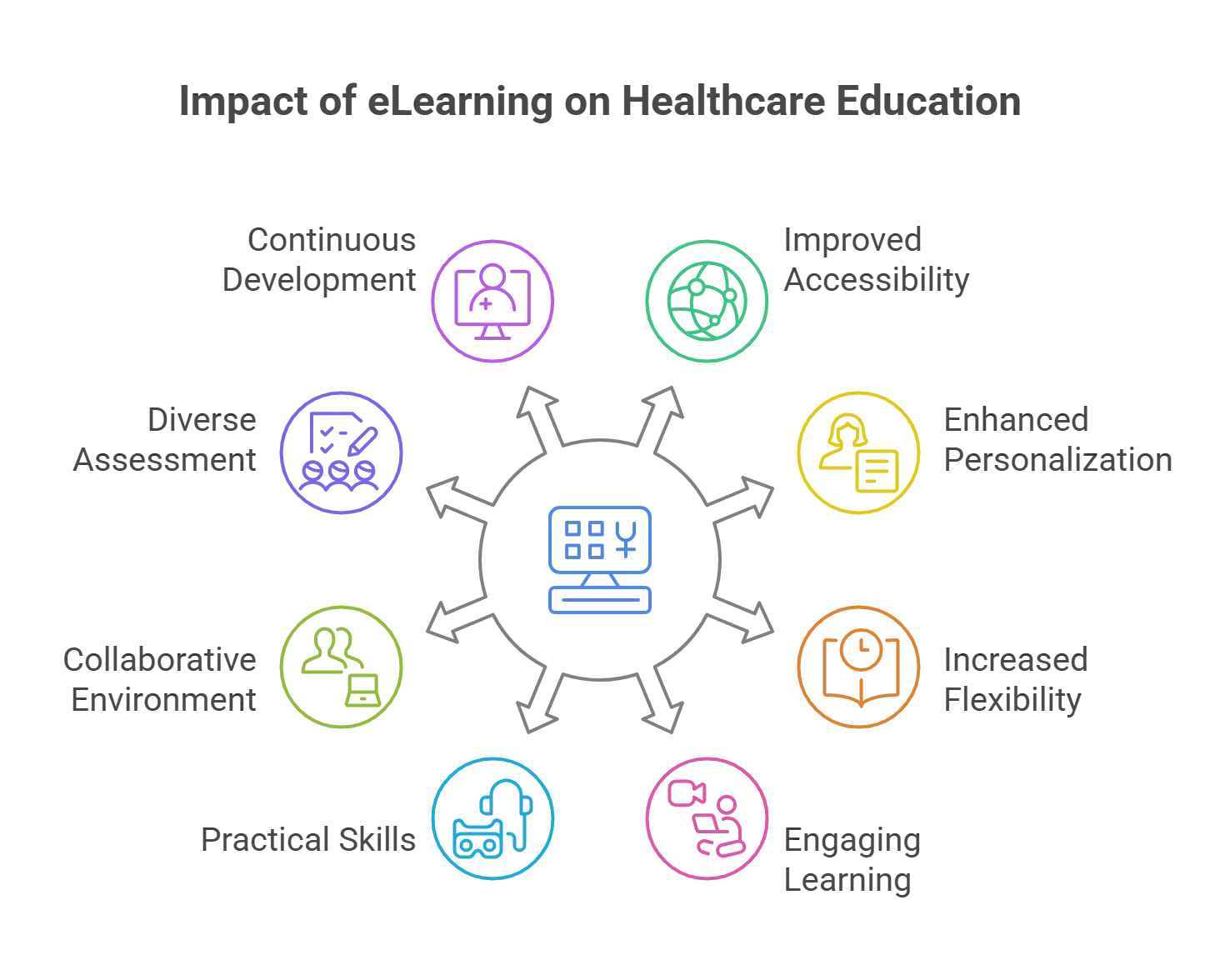
1. Improves Accessibility to Education
In a traditional learning scenario, students must attend classes at a specific time and place, limiting access to healthcare education. eLearning eliminates this limitation and widens the door for the delivery of healthcare education.
Digital education has enabled students to access healthcare education from the remotest parts of the country and the world with just a smart device and an internet connection. eLearning, thus, has removed geographical barriers and increased the accessibility of healthcare education to every person who wishes to enter the healthcare profession.
2. Improves Personalization of Education
Unlike traditional learning, which follows a one-size-fits-all approach, eLearning takes into account individual differences. eLearning development systems consider students’ unique learning goals, styles, strengths, and weaknesses. Based on this information, they curate tailored learning paths for each student accordingly.
In this way, eLearning caters to students’ learning needs and significantly improves healthcare education personalization, thereby boosting knowledge retention by up to 25–60%.
3. Improves Flexibility in Education
In a conventional education setup, students must attend lectures at set times every day, leaving little scope for flexibility. In contrast, eLearning provides a greater degree of flexibility.
eLearning has allowed students to study at a time convenient to them, enabling them to manage their family or work commitments smoothly. In addition, in medical eLearning, students can revisit concepts repeatedly until they understand them, facilitating self-paced learning. Moreover, this format allows students to build a strong foundation before moving on to complex topics, which is crucial in a field dealing with human lives.
eLearning has improved the convenience and flexibility of healthcare education for students and delivers positive learning outcomes.
4. Makes Education Fun and Engaging
Unlike traditional learning, which follows the monotonous pattern of the educator primarily imparting education, eLearning makes healthcare education far more fun and enjoyable.
In an eLearning scenario, students can watch videos, audio, images, animations, and more to understand medical concepts. They can also access updated interactive eBooks and explore the information provided in the hyperlinks. Thus, eLearning facilitates a deeper understanding of healthcare-related subject matters and provides a more engaging learning experience for students.
5. Makes Education More Practical
eLearning uses innovative technology to facilitate medical training and make education more practical. Technologies like AI, VR, and AR help create simulated scenarios where students can practice diagnosing and prescribing treatment. For example, in a simulated clinical setting, students can experience a conversation with a patient, thereby practically developing communication skills and learning about medical ethics.
Additionally, students can practice performing surgeries without risking any real harm to the patient. Thus, simulation-based learning helps students develop essential clinical, critical thinking, problem-solving, and decision-making skills, aiding them in becoming better healthcare practitioners.
6. Makes Education More Collaborative
eLearning provides opportunities for students to collaborate and interact through healthcare-related discussion boards, group projects, and research work. It enables them to connect with people from their country and across the globe, fostering a sense of global community.
Interaction with healthcare students from diverse backgrounds and cultures broadens students’ perspectives and improves their communication and networking skills. Thus, eLearning makes the healthcare learning experience more collaborative and interactive than traditional learning.
7. Increases the Number of Assessment Options in Education
In a traditional learning scenario, assessment involves pen-and-paper tests and practical exams. Unlike this, eLearning widens the scope of assessment in healthcare education and allows educators to set up wider, more detailed assessment criteria.
Educators can regularly evaluate students’ academic understanding after completing every unit with quizzes, MCQs, word clouds, projects, polls, and other online assessments. As a result, educators can track students’ academic performance throughout the year without hassle and provide them with timely feedback to improve their educational experience.
8. Enhances CPD in Healthcare Education
CPD (continuing professional development) is a crucial part of healthcare education. Even after acquiring a license, healthcare practitioners must pursue courses to stay up-to-date with the latest inventions in the medical community. Online learning courses enable them to learn about the latest research findings, updated diagnostic guidelines, and treatment protocols. In addition, they help them acquire the necessary education credits needed for license renewal.
Thus, eLearning makes it possible for healthcare practitioners to conveniently gain more knowledge and accreditations, aiding them in career development by enhancing their qualifications.
The End Note
eLearning has made a massive impact on healthcare education. With the global eLearning market expected to reach a whopping $400 billion by 2026, the impact will only increase, making it crucial to incorporate eLearning for healthcare education in educational and medical institutions.
Do you want to streamline the incorporation of eLearning into your educational institution? Outsourcing eLearning services from Hurix Digital can help.
Hurix Digital offers customized eLearning solutions to meet the needs of your educational institution. With the power of multimedia elements, gamification, AI, AR, and VR-based simulations, improve the quality of healthcare education and student learning outcomes. As one of the top-level eLearning companies in the US, Hurix Digital is trusted by Pearson, Cambridge University Press, McGraw Hill, and more.
To know more about custom eLearning solutions, get in touch with Hurix Digital.
Summarize with:

Senior Vice President
Julia brings over 20 years of global experience in digital learning and business strategy. She specializes in client success, enterprise learning solutions, and driving growth through innovation, with a focus on AI, VR, and emerging technologies across diverse industry verticals.
 Upcoming Masterclass | Build an Army of Brand Evangelists using Training & Development | November 20th, 8:30 AM PDT | 11:30 AM EDT | 10:00 PM IST
Upcoming Masterclass | Build an Army of Brand Evangelists using Training & Development | November 20th, 8:30 AM PDT | 11:30 AM EDT | 10:00 PM IST
